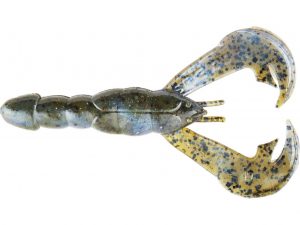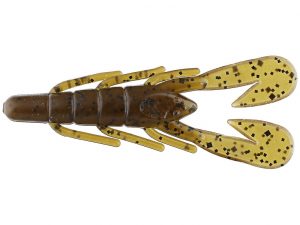The jig is a simple bait that you can cast and do just about any movement to catch fish. They can be considered the most productive baits known to man. Jigs are also known as big fish catchers.
The jig can be used to replicate shad, bluegill, bass, bait fish, and crawdads. You can just reel it back, shake it, stop and move it, flip it, jump it, yo-yo it and just about any method you can think of to catch bass.
The key is making your jig replicate what prey is in your lake. If your going for a bluegill replicate, then you must adjust your colors vs looking like a crawdad.
You should always keep a tight line in order feel the bite.
Jigs come in different shapes, sizes and colors. The head of the jig can determine what structure your fishing.
The jig can be broken down for 5 separate applications, but others do apply.
- Standing time, lay downs and wood
- Rocks and bluffs
- Docks and floating structure
- Grass and lily pads
- Drop shot
TYPES OF JIGS
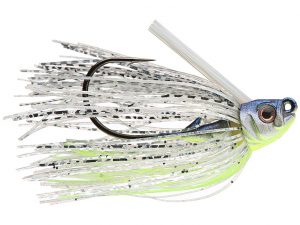 Swim Jig: The swim jig is one of the hottest jigs for catching bass. You retrieve the jig exactly as it’s called, swim it back to you. You fish this like you would any other bait such as spinnerbaits. This jig has a lighter weed guard and a bullet shaped head getting this jig to come thru the cover is key. You don’t want to hang up on everything. This jig types your trying to replicate bait fish and the erratic movement you will use looks just like a fish swimming in water.
Swim Jig: The swim jig is one of the hottest jigs for catching bass. You retrieve the jig exactly as it’s called, swim it back to you. You fish this like you would any other bait such as spinnerbaits. This jig has a lighter weed guard and a bullet shaped head getting this jig to come thru the cover is key. You don’t want to hang up on everything. This jig types your trying to replicate bait fish and the erratic movement you will use looks just like a fish swimming in water.
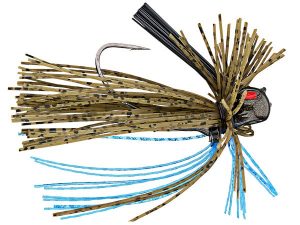 Finesse Jig: This jig works well with a creature bait or crawdad trailer. You retrieve the jig in numerous manors to act as a crawdad. Moving it slowly with small advances can be deadly. The key is in its name, Finesse. Taking your time and working your jig slowly like a moving crawdad or even a dying crawdad is your goal.
Finesse Jig: This jig works well with a creature bait or crawdad trailer. You retrieve the jig in numerous manors to act as a crawdad. Moving it slowly with small advances can be deadly. The key is in its name, Finesse. Taking your time and working your jig slowly like a moving crawdad or even a dying crawdad is your goal.
This works well in cold water. Working it near structure can payoff big time. This jig has a spider looking skirt and a light hook. It is very popular in pressured area where anglers fish it often. You can work this jig slow and fast but working it slow can be the payoff.
This jig has a ball shaped head which sometimes makes it roll to one side or another while resting. That could make the bass think its dead and it’s an easy meal. Your goal is to replicate a crawdad type of bait in most cases.
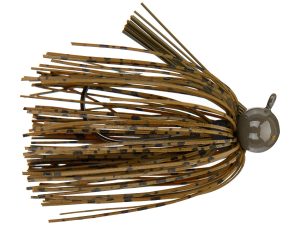 Football jig: My favorite jig especially here on Table Rock Lake due to all the rock structure. You retrieve this jig close to the manor of the finesse jig. It’s a different action compared to the finesse jig. Remember the finesse jig had a ball shaped head, which hangs in in rocks faster. The football head stands up for the most part, and not rock so much side to side.
Football jig: My favorite jig especially here on Table Rock Lake due to all the rock structure. You retrieve this jig close to the manor of the finesse jig. It’s a different action compared to the finesse jig. Remember the finesse jig had a ball shaped head, which hangs in in rocks faster. The football head stands up for the most part, and not rock so much side to side.
The jig kind of rolls forward when pulled lightly. Another way is to cast it and allow it to rest on the bottom, shake it a bit and let it rest, shake it some more before you move it. You can also throw your jig and keep your rod tip up and allow the jig to fall all the way back to your boat. This jig is very popular to replicate a crawdad and it’s one of the best to do so. The movement can be accomplished by short pulls, high pulls to mimic it darting away from something, or even fast movements.
This jig works in all types of water temperatures. Since this bait is built for rock type structure or bluffs, it’s easy to bring thru large boulders, chunk rock and even pea gravel. The head is just like its name, a football shape.
The football jig has a stronger weed guard to withstand rocks and hard types of cover. It’s not the best jig for wood or standing timber.
 Flipping jig: The flipping jig is designed for flipping cover. Works extremely well on boat docks, standing timber and lay-downs. Your retrieve is close to the swim jig and your trying to look like a crawdad or bait fish falling or in a dying action. Your retrieve can vary from working it like the bait fish, with erratic movements, swimming it, even allowing it to fall like a dying prey. This jig has a recessed eye. The head is typically flat on one side and rounded or beveled on one side. I like this jig to mimic bluegill, especially on boat docks.
Flipping jig: The flipping jig is designed for flipping cover. Works extremely well on boat docks, standing timber and lay-downs. Your retrieve is close to the swim jig and your trying to look like a crawdad or bait fish falling or in a dying action. Your retrieve can vary from working it like the bait fish, with erratic movements, swimming it, even allowing it to fall like a dying prey. This jig has a recessed eye. The head is typically flat on one side and rounded or beveled on one side. I like this jig to mimic bluegill, especially on boat docks.
The weed guard is firm but have some give to allow the bass to get to the hook easily.
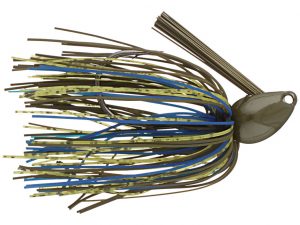 Grass or lily pad jig: The grass or lily pad jig is for working just as its name, grass or lily pads. It can penetrate the grass or lily pads effortlessly due to its head shape and heaver weight. Your retrieve will mimic baitfish most times. Working it under grass or lily pads where the fish are present is the purpose of this jig. The hook is stronger here but don’t hang or drag back grass or lily pads as bad. This jig should be fished on heaver line due to the structure it fishes.
Grass or lily pad jig: The grass or lily pad jig is for working just as its name, grass or lily pads. It can penetrate the grass or lily pads effortlessly due to its head shape and heaver weight. Your retrieve will mimic baitfish most times. Working it under grass or lily pads where the fish are present is the purpose of this jig. The hook is stronger here but don’t hang or drag back grass or lily pads as bad. This jig should be fished on heaver line due to the structure it fishes.
Getting this bait to the bottom of the lake can allow you to mimic a crawdad.
This bait is fun and takes some time to get the hang of it. Often you think you have a fish on but you’re just hanging up on some type of structure, lily pad stalks, or chunks of grass. It will pull thru it, but you have to determine if you have caught a fish or just snagged.
The head is almost shaped like an arrowhead with a small nose gaining girth as you get towards the skirt.
COLORS
This discussion can go one for hours about each person’s favorite color. Here on Table Rock Lake, a crawdad pattern and colors are deadly. Crawdad colors vary from lake to lake. You must know your prey’s colors to be successful. Here on Table Rock Lake, I just basically five separate colors.
I use a PB&J, green pumpkin, green pumpkin with some orange, Missouri craw and black and blue. Don’t limit yourself with these colors, you must match your prey’s color in each different lake.
Table Rock Lake is known for very clear water and that’s why I like the jug some much. The PB&J, green pumpkin and green pumpkin with some orange match our crawdads. If you find yourself in some of the river arms with stained water or even muddy water, getting some brighter colors in your jig can make you more successful.
Jig weights: Jig weights vary from 1/8 oz all the way to 1 ½ to even 2 oz. In the clear water at Table Rock Lake, sometimes lighter weights can be more productive. Often anglers using light weights such as a ¼ oz will use a spinning reel. The lighter weights change the movement of the bait. It moves and drops slower to mimic the crawdad. This weight is good for water up to 15’ deep.
If your fishing 10’ to 20’ the ½ oz or ¾ oz could be your best selection. Over 20’ you tend to use a ¾ or 5/8 oz. Sometimes on the gravel flats in the summer I drag a 1 oz jig and move it fast from shallow to over the roll offs to deeper water. I have found the 1 oz on pea gravel works better for me.
A theory is to use the lightest weight jig and you can. It can be dependent with the water depth your fishing and even the wind.
Jig trailers: The jig trailer is the most important part of the jig’s success. You will find countless of trailers on the market in sizes, shapes and colors. You need to match your trailer with the prey you are trying to mimic.
If I’m using a jig to mimic a crawdad, I like a trailer with long and heavy pincers. This gives you a ton of action and displaces water well on the fall and in movement. If’s I’m trying to mimic a bluegill, I may use a paddle tail Keitech, beaver style, creature style, grubs or other plastics with a great deal of action.
My favorite trailer for the football jig miming a crawdad is the Strike King Rage Craw. It comes with a slender body and large heavy pincers.
Trailers such as chunks, craws, creatures, swimbaits, grubs and twin tails all are good selections for jig fishing.
MOVEMENT
If you ask any angler, they will tell you several different ways to move your jig. You will find in cold water that a slow-paced retrieve is key. When you get into the late spring and summer, you can move your jig much faster to cover more water.
It all boils down to this. You want to move your jig in the exact manor to mimic the prey.
How I learned to fish jigs, is that I went on YouTube and watched video’s on crawdad movements, fish movements and swimming patterns. I fish a crawdad pattern jig most often, so I watched a great deal of videos on the crawdad movement. I watched the crawdad just move slowly like its walking and running from something.
You can add rattles to your jig to attract more attention.
ABOUT THE AUTHOR.
Chris Gibbons is the host of the Table Rock Lake Fishing Report videoed on Facebook several times a week. This fishing report has over 6000 followers from 26 states and 7 countries. It has an average of 1500-3000 daily hits.
Chris has been bass fishing for 40 years and last five on Table Rock Lake.


